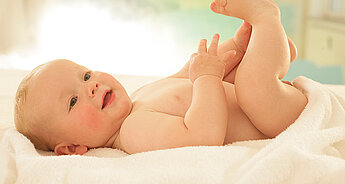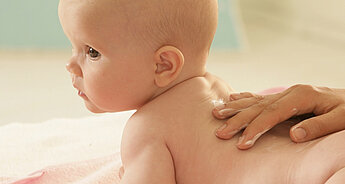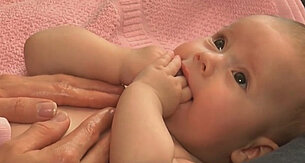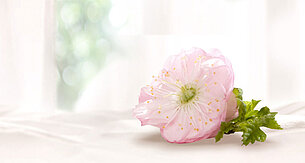How to change your baby’s nappies

Let’s start with some trivia. You will need to change around 4,000 nappies before your child is potty trained. Newborns urinate up to 20 times per day.
So, since you’ll have to change quite a few nappies, here are some tips that will help you to master this task:
What you’ll need for a nappy change:
- a soft washcloth and warm water, a dry baby wipe and baby oil or a wet wipe
- nappy rash cream (if necessary)
- a fresh nappy
- for older babies, a toy to distract them
What to do
Depending on your baby’s age, either give the mobile a twirl or keep a toy on hand to distract them.
Now start by taking off the used nappy. Gently clean your baby’s nappy area with a washcloth, an oily wipe or a wet wipe. Carefully, but thoroughly, pat your baby’s sensitive skin dry or allow it to air dry. Thorough cleansing is particularly important after each bowel movement. If necessary, apply some nappy rash cream. Then put a clean nappy on your baby.
Never leave your baby unattended on the changing table.
Changing a baby girl:
Always wipe from front to back so that no intestinal bacteria can enter the vagina.
Changing a baby boy:
Cover the penis with a cloth or nappy in order to avoid being accidentally weed on.
Nappy rash and how to avoid it

Frequently occurring nappy rash may be caused by the nappy itself, too much moisture or too little skin exposure to fresh air. Inelastic nappies can often lead to chafing in the nappy area. Moisture from urine and stool that is not absorbed by the nappy can irritate sensitive baby skin. Bacteria from the stool and certain components of urine can be an additional strain on the skin.
What helps to protect my baby’s skin?
- Change your baby’s nappies often as dry nappies can reduce skin irritation.
- Use highly absorbent and elastic nappies.
- The nappy should never be too tight. You should be able to fit one to two fingers between their tummy and the nappy.
- To avoid soreness, make sure to dry your baby’s skin thoroughly after cleansing their nappy area and don’t forget about the skin folds. Always gently pat the skin dry and do not rub or use a hairdryer.
- Let them wriggle about without a nappy on as often as possible to allow air to reach their bottom. Your little one will love it!
- You can apply barrier cream to their bottom as a preventative measure to protect their skin against the damaging effects of stool and urine. Creams containing zinc are ideal for additional protection against moisture.
As it’s a whole lot easier to prevent nappy rash than it is to treat it, parents should follow the “ABCDE” rules. This way, they can make sure that their baby’s bottom does not become irritated or suffer a painful nappy rash.
Air: Children not wearing nappies do not get nappy rash, so we recommend letting them go without one as often as possible.
Barriers: Allow the skin barrier to recover properly. A barrier cream with zinc can help protect the skin from wee and poo.
Cleansing: Frequently changing their nappies, gently cleansing the nappy area and thoroughly patting their skin dry is what you need to do to keep your baby’s skin healthy.
Disposable nappies: To protect your baby’s skin it’s best to use extra soft and absorbent nappies.
Education: Knowledge and information can help parents prevent their baby’s skin from becoming irritated.
Nappy rash cream and wet wipes
Wet wipes are particularly popular, and with good reason, since they are especially practical when you are out and about. They are also ideal for cleaning hands and faces. We recommend using wet wipes that are free from preservatives and perfumes. Our unscented HiPP Ultra Sensitive Wet Wipes .meet these requirements.
To protect the skin against aggressive bodily fluids, we recommend using a nappy rash cream every time you change your baby’s nappy. You should opt for creams that contain zinc as it protects the skin against irritation while also speeding up the healing process. As a preventative measure, we recommend using a rich, water-repellent barrier cream. Our HiPP Nappy Rash Cream and HiPP SOS Nappy Rash Cream tick all these boxes.



